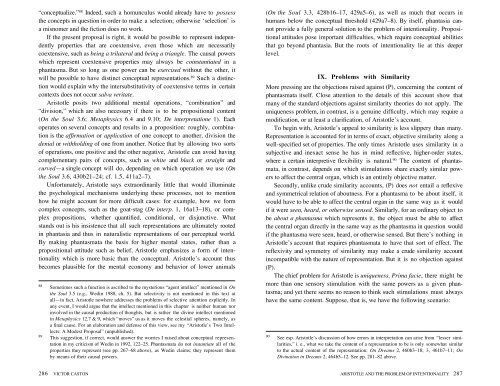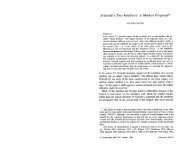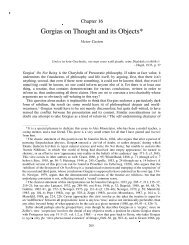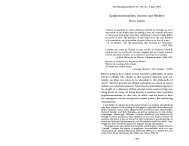Aristotle and the Problem of Intentionality. - Ancient Philosophy ...
Aristotle and the Problem of Intentionality. - Ancient Philosophy ...
Aristotle and the Problem of Intentionality. - Ancient Philosophy ...
You also want an ePaper? Increase the reach of your titles
YUMPU automatically turns print PDFs into web optimized ePapers that Google loves.
“conceptualize.” 88 Indeed, such a homunculus would already have to possess<strong>the</strong> concepts in question in order to make a selection; o<strong>the</strong>rwise ‘selection’ isa misnomer <strong>and</strong> <strong>the</strong> fiction does no work.If <strong>the</strong> present proposal is right, it would be possible to represent independentlyproperties that are coextensive, even those which are necessarilycoextensive, such as being a trilateral <strong>and</strong> being a triangle. The causal powerswhich represent coextensive properties may always be coinstantiated in aphantasma. But so long as one power can be exercised without <strong>the</strong> o<strong>the</strong>r, itwill be possible to have distinct conceptual representations. 89 Such a distinctionwould explain why <strong>the</strong> intersubstitutivity <strong>of</strong> coextensive terms in certaincontexts does not occur salva veritate.<strong>Aristotle</strong> posits two additional mental operations, “combination” <strong>and</strong>“division,” which are also necessary if <strong>the</strong>re is to be propositional content(On <strong>the</strong> Soul 3.6; Metaphysics 6.4 <strong>and</strong> 9.10; De interpretatione 1). Eachoperates on several concepts <strong>and</strong> results in a proposition: roughly, combinationis <strong>the</strong> affirmation or application <strong>of</strong> one concept to ano<strong>the</strong>r, division <strong>the</strong>denial or withholding <strong>of</strong> one from ano<strong>the</strong>r. Notice that by allowing two sorts<strong>of</strong> operations, one positive <strong>and</strong> <strong>the</strong> o<strong>the</strong>r negative, <strong>Aristotle</strong> can avoid havingcomplementary pairs <strong>of</strong> concepts, such as white <strong>and</strong> black or straight <strong>and</strong>curved—a single concept will do, depending on which operation we use (On<strong>the</strong> Soul 3.6, 430b21–24; cf. 1.5, 411a2–7).Unfortunately, <strong>Aristotle</strong> says extraordinarily little that would illuminate<strong>the</strong> psychological mechanisms underlying <strong>the</strong>se processes, not to mentionhow he might account for more difficult cases: for example, how we formcomplex concepts, such as <strong>the</strong> goat-stag (De interp. 1, 16a13–18), or complexpropositions, whe<strong>the</strong>r quantified, conditional, or disjunctive. Whatst<strong>and</strong>s out is his insistence that all such representations are ultimately rootedin phantasia <strong>and</strong> thus in naturalistic representations <strong>of</strong> our perceptual world.By making phantasmata <strong>the</strong> basis for higher mental states, ra<strong>the</strong>r than apropositional attitude such as belief, <strong>Aristotle</strong> emphasizes a form <strong>of</strong> intentionalitywhich is more basic than <strong>the</strong> conceptual. <strong>Aristotle</strong>’s account thusbecomes plausible for <strong>the</strong> mental economy <strong>and</strong> behavior <strong>of</strong> lower animals88 Sometimes such a function is ascribed to <strong>the</strong> mysterious “agent intellect” mentioned in On<strong>the</strong> Soul 3.5 (e.g., Wedin 1988, ch. 5). But selectivity is not mentioned in this text atall—in fact, <strong>Aristotle</strong> nowhere addresses <strong>the</strong> problems <strong>of</strong> selective attention explicitly. Inany event, I would argue that <strong>the</strong> intellect mentioned in this chapter is nei<strong>the</strong>r human norinvolved in <strong>the</strong> causal production <strong>of</strong> thoughts, but is ra<strong>the</strong>r <strong>the</strong> divine intellect mentionedin Metaphysics 12.7 & 9, which “moves” us as it moves <strong>the</strong> celestial spheres, namely, asa final cause. For an elaboration <strong>and</strong> defense <strong>of</strong> this view, see my “<strong>Aristotle</strong>’s Two Intellects:A Modest Proposal” (unpublished).89 This suggestion, if correct, would answer <strong>the</strong> worries I raised about conceptual representationin my criticism <strong>of</strong> Wedin in 1992, 122–25. Phantasmata do not instantiate all <strong>of</strong> <strong>the</strong>properties <strong>the</strong>y represent (see pp. 267–68 above), as Wedin claims; <strong>the</strong>y represent <strong>the</strong>mby means <strong>of</strong> <strong>the</strong>ir causal powers.(On <strong>the</strong> Soul 3.3, 428b16–17, 429a5–6), as well as much that occurs inhumans below <strong>the</strong> conceptual threshold (429a7–8). By itself, phantasia cannotprovide a fully general solution to <strong>the</strong> problem <strong>of</strong> intentionality. Propositionalattitudes pose important difficulties, which require conceptual abilitiesthat go beyond phantasia. But <strong>the</strong> roots <strong>of</strong> intentionality lie at this deeperlevel.IX. <strong>Problem</strong>s with SimilarityMore pressing are <strong>the</strong> objections raised against (P), concerning <strong>the</strong> content <strong>of</strong>phantasmata itself. Close attention to <strong>the</strong> details <strong>of</strong> this account show thatmany <strong>of</strong> <strong>the</strong> st<strong>and</strong>ard objections against similarity <strong>the</strong>ories do not apply. Theuniqueness problem, in contrast, is a genuine difficulty, which may require amodification, or at least a clarification, <strong>of</strong> <strong>Aristotle</strong>’s account.To begin with, <strong>Aristotle</strong>’s appeal to similarity is less slippery than many.Representation is accounted for in terms <strong>of</strong> exact, objective similarity along awell-specified set <strong>of</strong> properties. The only times <strong>Aristotle</strong> uses similarity in asubjective <strong>and</strong> inexact sense he has in mind reflective, higher-order states,where a certain interpretive flexibility is natural. 90 The content <strong>of</strong> phantasmata,in contrast, depends on which stimulations share exactly similar powersto affect <strong>the</strong> central organ, which is an entirely objective matter.Secondly, unlike crude similarity accounts, (P) does not entail a reflexive<strong>and</strong> symmetrical relation <strong>of</strong> aboutness. For a phantasma to be about itself, itwould have to be able to affect <strong>the</strong> central organ in <strong>the</strong> same way as it wouldif it were seen, heard, or o<strong>the</strong>rwise sensed. Similarly, for an ordinary object tobe about a phantasma which represents it, <strong>the</strong> object must be able to affect<strong>the</strong> central organ directly in <strong>the</strong> same way as <strong>the</strong> phantasma in question wouldif <strong>the</strong> phantasma were seen, heard, or o<strong>the</strong>rwise sensed. But <strong>the</strong>re’s nothing in<strong>Aristotle</strong>’s account that requires phantasmata to have that sort <strong>of</strong> effect. Thereflexivity <strong>and</strong> symmetry <strong>of</strong> similarity may make a crude similarity accountincompatible with <strong>the</strong> nature <strong>of</strong> representation. But it is no objection against(P).The chief problem for <strong>Aristotle</strong> is uniqueness. Prima facie, <strong>the</strong>re might bemore than one sensory stimulation with <strong>the</strong> same powers as a given phantasma;<strong>and</strong> yet <strong>the</strong>re seems no reason to think such stimulations must alwayshave <strong>the</strong> same content. Suppose, that is, we have <strong>the</strong> following scenario:90 See esp. <strong>Aristotle</strong>’s discussion <strong>of</strong> how errors in interpretation can arise from “lesser similarities,”i. e., what we take <strong>the</strong> content <strong>of</strong> a representation to be is only somewhat similarto <strong>the</strong> actual content <strong>of</strong> <strong>the</strong> representation: On Dreams 2, 460b3–18; 3, 461b7–11; OnDivination in Dreams 2, 464b5–12. See pp. 281–82 above.286 VICTOR CASTONARISTOTLE AND THE PROBLEM OF INTENTIONALITY 287





